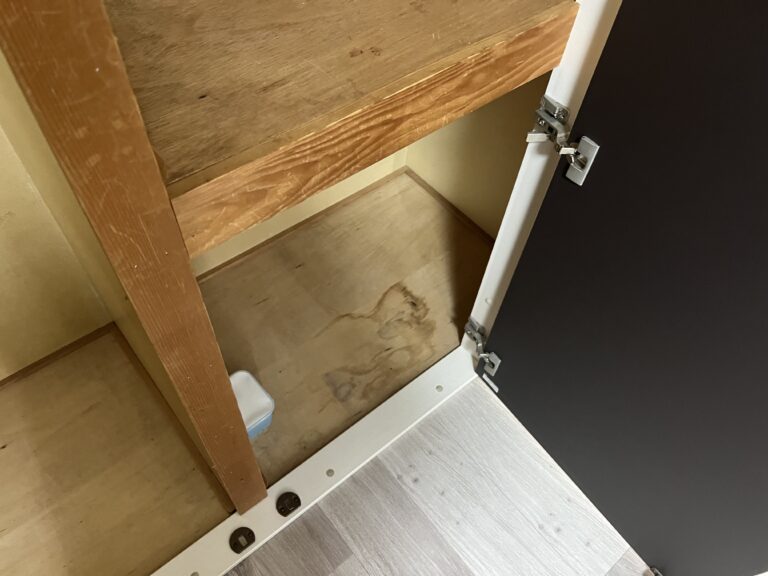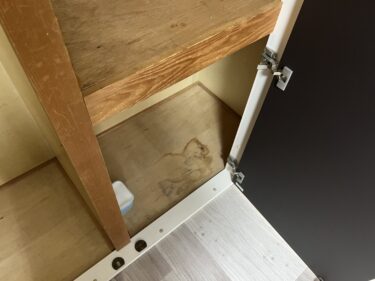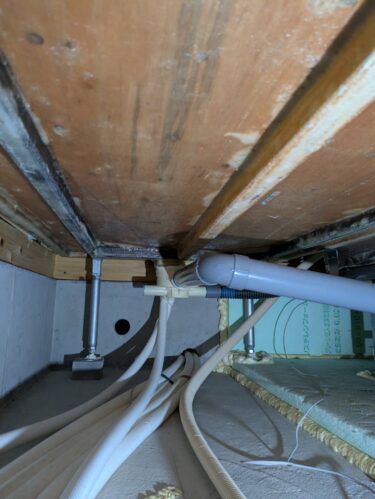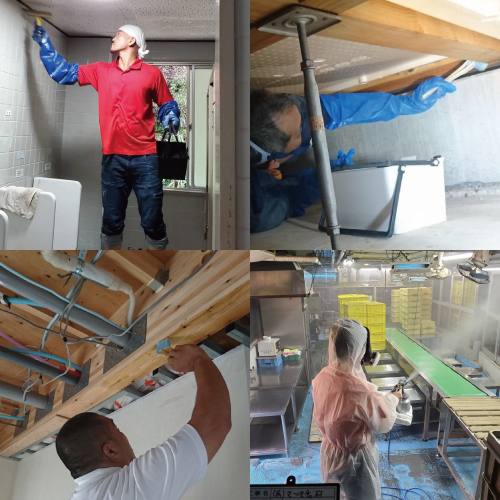1. Situations of Mold Trouble in Kansai and Osaka
Kansai, especially Osaka, experiences high humidity year-round, providing ideal conditions for mold proliferation. This affects not only standard homes but also luxury residences and large-scale facilities. Mold often takes hold in hidden areas like ceilings, under floors, and within walls. In upscale, airtight, and well-insulated homes favored by affluent clients, moisture and organic matter can accumulate unnoticed, causing mold growth. This not only causes unsightly stains and odors but also poses risks to respiratory health and structural integrity.
1.1. The Combined Effect of Climate and Urban Structure
Osaka’s urban heat island phenomenon raises local temperatures and humidity, while dense neighborhood housing diminishes airflow and sunlight. These conditions trap moisture in concealed spaces like between walls and under floorboards. Such areas are difficult to inspect visually, allowing mold to spread widely before detection. In airtight homes, sealed insulation can trap condensation, making hidden mold growth a serious concern.
1.2. Air Quality Troubles in Luxury Homes
Luxury homes equipped with high-performance insulation and airtight construction are energy-efficient but prone to reduced airflow. During humid seasons, inadequate humidity control can result in moldy odors and airborne spores. Early signs such as a musty smell, powdery residue in closets, or black stains on window seals may indicate mold spread. Natural-material furnishings used in upscale homes can absorb moisture, weakening structural and aesthetic value—prompt detection and remediation are vital to preserving property.
2. Mold Damage Caused by Water Leaks and Condensation
Water intrusion—through plumbing leaks, roof issues, or condensation—is often overlooked as a mold trigger. In luxury homes and welfare facilities, complex structures allow moisture to accumulate in hidden areas, facilitating mold growth. If left unaddressed, this can lead to material degradation, reduced insulation performance, and persistent odors.
2.1. Invisible Infestation in Ceilings and Walls
Leaks in roofs or piping first soak into ceiling cavities or wall interiors. By the time damp spots appear, mold may already be widespread. Mold inside walls may not be visible yet spores circulate in the air, posing health hazards. In ceilings, damp insulation fosters mold that can permeate the entire indoor environment with musty smells.
2.2. Structural Damage from Underfloor Moisture
Underfloor spaces often accumulate moisture, especially with poor ventilation. Faulty plumbing or drainage can saturate wood joists and insulation beneath the floor, leading to mold growth. Over time, decay-causing organisms compromise structural components, weakening foundations. In welfare facilities, mold odors and airborne contaminants from below can affect residents’ health, making prompt detection and remediation critical.
3. Health Risks in Welfare Facilities and Elderly Housing
Welfare facilities house vulnerable residents—children, the elderly, or those with immune conditions—who are particularly prone to health issues from mold. Airborne spores and mycotoxins (mold toxins) pose serious concerns, necessitating stringent protection protocols.
3.1. Respiratory Illnesses and Allergies from Mold Spores
Inhaling mold spores can trigger asthma attacks, allergic rhinitis, and respiratory conditions. Those with weakened immune systems or existing respiratory conditions are at higher risk. Mold can also affect skin and eyes, causing itching, redness, or dermatitis. Recurring complaints by residents may indicate hidden mold contamination in the facility.
3.2. Immunosuppression from Mycotoxins
Certain molds produce mycotoxins—like aflatoxin and trichothecene—that interfere with immunity and organ function. Aflatoxin is known for its liver toxicity and carcinogenicity, while trichothecenes suppress immune defenses, increasing infection susceptibility. Moldy buildings risk chronic exposure, potentially worsening residents’ health, underlining the need for air-quality monitoring and thorough remediation.
4. Odor Issues in Luxury Homes
A persistent moldy smell—often referred to as “mustiness”—can severely affect luxury properties. Even with beautiful interiors, an unpleasant odor diminishes comfort and market value. During visits or viewings, odors can leave a negative impression, harming the owner’s reputation and diminishing perceived luxury.
4.1. Value Loss and Tarnished Prestige
Luxury properties are valued for comfort and aesthetics. Mold odors infiltrate walls, curtains, and furniture, making them difficult to remove. As eradication costs rise, property values decline. During showings, any hint of mold odor can deter buyers or tenants, undermining market appeal and social status.
4.2. Source Identification and Odor Removal Strategy
Eradicating musty smells requires pinpointing their source—unit interiors, closets, under floors, wall cavities, HVAC systems, and carpets are common culprits. HVAC systems can broadcast spores when turned on. Once identified, targeted sanitization methods—like ozone treatment, ionization, or professional deodorization—can neutralize odor molecules, restoring air quality and luxury ambiance.
5. Importance of Inspecting Underfloors and Ceilings
Mold often colonizes areas hidden from daily view—ceilings and underfloors—which delay detection and allow problems to escalate. Regular inspections and maintenance ensure early detection and prevention, preserving building integrity.
5.1. Benefits of Professional Periodic Inspection
Homeowners typically can’t inspect under floors or above ceilings. Professionals use thermal cameras, hygrometers, borescopes, and humidity sensors to uncover moisture pockets and mold spores in hidden zones. Early-stage mold is detected sooner, enabling cost-effective and less invasive interventions and maintaining building health.
5.2. Preventive Measures: Ventilation, Moisture Barriers, and Repairs
To prevent mold, moisture management is crucial. Installing underfloor ventilation vents or mechanical systems supports airflow. Vapor barriers and proper insulation reduce condensation risk. Replacing damaged insulation and wet wood quickly interrupts mold-friendly conditions. These practices lower mold risk at the source and require minimal visual intervention.
6. Health Impacts of Mycotoxins
Mycotoxins are toxic compounds produced by certain mold species. Even low-level exposure in homes can cause chronic health issues, especially in children, seniors, and immunocompromised individuals.
6.1. Toxic Mechanisms—Aflatoxin and Beyond
Aflatoxin, ochratoxin, and trichothecenes are among the most concerning. Produced by specific molds, they can be inhaled or absorbed through skin. Aflatoxin is hepatotoxic and carcinogenic. Trichothecenes suppress immunity and can damage internal organs. While often associated with contaminated food, inhalation exposure in damp indoor environments can be equally harmful.
6.2. Long-Term Risks: Cancer and Organ Damage
Chronic exposure to mycotoxins is linked to increased cancer risk, kidney and lung damage, and other chronic illnesses. Suppressed immunity increases susceptibility to infections and worsens autoimmune disorders. Air purifiers alone often fail to eliminate spores, underscoring the need for professional remediation and environmental corrections.
7. Preventive Measures for Luxury Homes
Luxury homes often prioritize design over indoor air control. To safeguard health and value, tailored prevention strategies are essential.
7.1. Indoor Air Quality Testing and Mold Inspection
At first sign of mildew or mustiness, professional air-quality tests should be conducted—testing spore counts and detecting mycotoxins. Surface samples from walls or ceilings help identify mold types and infestation levels. Results inform customized remediation and prevention plans.
7.2. Asset Protection with Mold-Resistant Renovations
High-end homes benefit from mold-resistant materials, eco-friendly antimicrobial coatings, and humidity-regulating paints. Structural improvements—like better underfloor ventilation or wall vapor barriers—prevent moisture buildup. These measures maintain property aesthetics while preventing mold resurgence, protecting health and asset value.
8. Specialized Measures for Welfare Facilities
Welfare and care facilities, with shared environments, risk rapid mold spread. Rigorous hygiene standards are essential.
8.1. Safe Treatments for Seniors and Infants
Care centers require mold remediation that is both effective and safe. Eco-friendly biocidal cleaners and enzymatic treatments kill mold without harmful residue. These methods allow residents to remain onsite without exposure to harsh chemicals or disruptions.
8.2. Continuous sanitation and facility management
Post-remediation, ongoing monitoring keeps mold at bay. Scheduled inspections of underfloor and wall spaces, routine HVAC filter replacements, and staff checks for signs of moisture or odor help maintain a healthy environment. Daily vigilance ensures a consistently safe facility atmosphere.
9. Advantages of Hiring Professional Contractors
Addressing mold requires more than surface cleaning—it needs expert analysis, equipment, and materials.
9.1. Root-Cause Resolution for Leaks and Condensation
Mold always has a source—leaks or condensation must be resolved, or mold returns. Professionals detect hidden moisture pathways and atmospheric dynamics, developing a remediation plan. This “root-cause” approach avoids recurring issues and ensures lasting outcomes.
9.2. Professional Agents and Techniques for Reoccurrence Prevention
Professional-grade biocides break down mold cell structures effectively. These cleaners are formulated to protect materials while killing mold. Preventive treatments form barriers and remove airborne spores. This comprehensive strategy significantly reduces the likelihood of mold returning.
10. Mold Trouble Response Flowchart
When mold appears, efficient, orderly response ensures containment and recovery.
10.1. Immediate Response Steps
First, ventilate the area and reduce humidity to prevent spread. Photograph and document mold locations. For small, isolated patches, wear protective gear (mask, gloves) and use alcohol-based or diluted bleach cleaners for spot treatment. For extensive mold (>0.5 m²) or recurring issues, contact professionals without delay.
10.2. Long-Term Prevention and Maintenance
After initial containment or removal, schedule a professional inspection for broader assessment. Implement moisture-control methods like vapor barriers, ventilation upgrades, and insulation repairs. Establish a long-term maintenance plan with regular monitoring and air-quality testing. These actions create a mold-resistant environment sustained over time.





